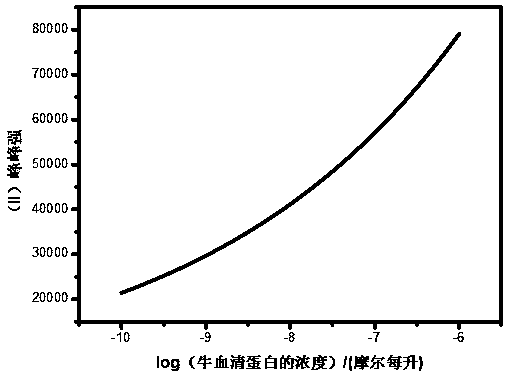A nanoprobe device for Raman-enhanced protein detection and its preparation method
A protein detection and nano-probe technology, which is applied in the field of life analysis chemistry and nano-materials, can solve the problems of low repeatability of the preparation method, high preparation cost, complicated operation, etc., and achieve simple process, high sensitivity and simple operation Effect
- Summary
- Abstract
- Description
- Claims
- Application Information
AI Technical Summary
Problems solved by technology
Method used
Image
Examples
Embodiment 1
[0029] 1. Preparation of PS-CHO microspheres:
[0030] (1) Add 17.6mL of absolute ethanol, 20.8mL of deionized water and 2.1g of polyvinylpyrrolidone (PVP) into a three-necked flask equipped with a condenser, and place it in a constant temperature water bath at 70°C, mechanically stir and keep The rotating speed is 315r / min.
[0031] (2) Dissolve 0.1g of initiator AIBN in 6mL of styrene to obtain monomeric styrene in which initiator AIBN is dissolved.
[0032] (3) Add styrene monomer dissolved in initiator AIBN to the system obtained in (1), and add 6 mL of acrolein (C 3 h 4 O), after constant temperature reaction for 7 hours, add hydrochloric acid and increase the temperature of the constant temperature water bath to 80° C. for 12 hours, and then stop the reaction. Wash with ethanol / water and sonicate several times to obtain PS-CHO emulsion.
[0033] 2. Preparation of PS-CHO@Ag composite microspheres:
[0034] Take 0.02gAgNO 3 Dissolve in 1mL of deionized water, drop in...
Embodiment 2
[0044] The same steps as in Example 1 will not be repeated here, only the concentration of the BSA protein solution prepared in step 3 is changed: BSA protein is dispersed in 10mM phosphate buffered saline solution (PBS, pH7.2) to prepare 10-7 mol / L BSA solution.
[0045] Other steps are the same as in Example 1.
Embodiment 3
[0047] The same steps as in Example 1 will not be repeated here, only the concentration of the BSA protein solution prepared in step 3 is changed: the BSA protein is dispersed in 10 mM phosphate buffered saline solution (PBS, pH 7.2), and 10 -8 mol / L BSA solution.
[0048] Other steps are the same as in Example 1.
PUM
| Property | Measurement | Unit |
|---|---|---|
| particle diameter | aaaaa | aaaaa |
| particle size | aaaaa | aaaaa |
Abstract
Description
Claims
Application Information
 Login to View More
Login to View More - R&D
- Intellectual Property
- Life Sciences
- Materials
- Tech Scout
- Unparalleled Data Quality
- Higher Quality Content
- 60% Fewer Hallucinations
Browse by: Latest US Patents, China's latest patents, Technical Efficacy Thesaurus, Application Domain, Technology Topic, Popular Technical Reports.
© 2025 PatSnap. All rights reserved.Legal|Privacy policy|Modern Slavery Act Transparency Statement|Sitemap|About US| Contact US: help@patsnap.com



